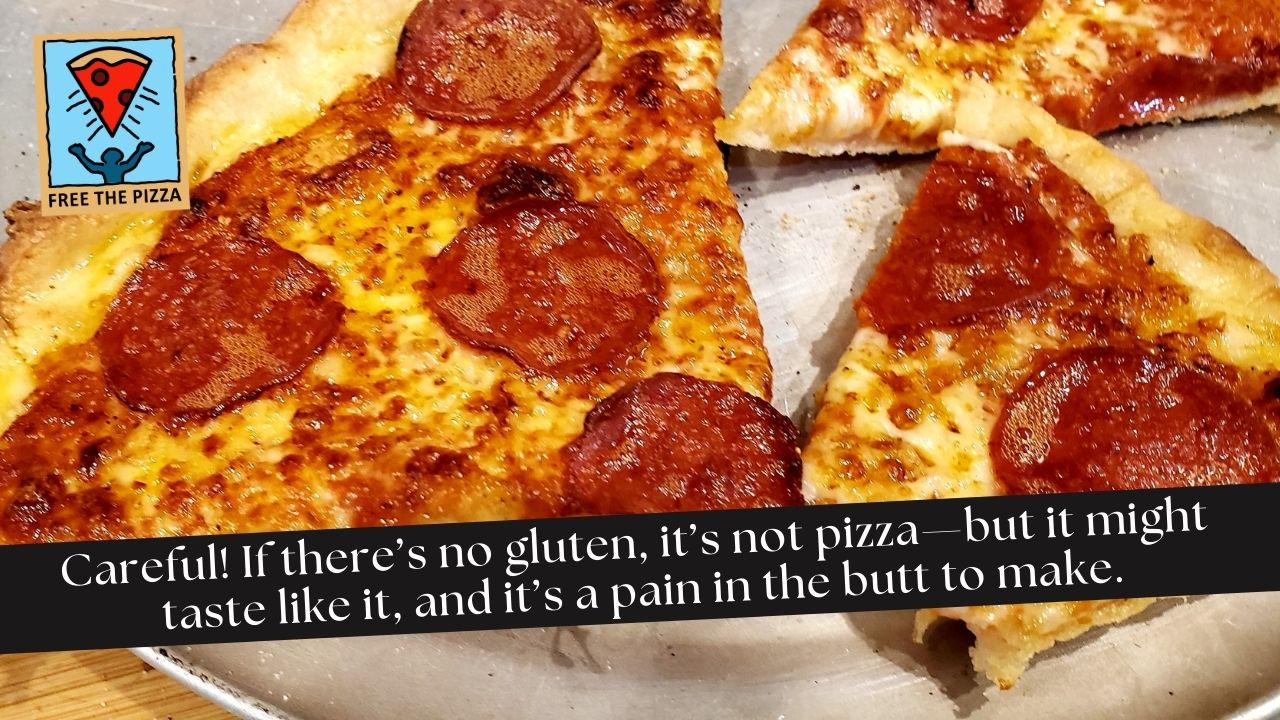|
WARNING: This blog post does not constitute medical advice or any dietary recommendations regarding celiac disease, gluten intolerance or wheat allergies. It is for entertainment purposes only. I have eaten gluten-free pizza, and it was fantastic. Unfortunately, it was not a pizza that I had made. With 20 years of pizza making and over a thousand pizzas under my belt, I’m still trying to make gluten-free pizza myself. I keep trying these things, in fact, so that you don’t have to. Once I can get it down and it’s easy to do, I offer it to you. So if you wish, you can leave right now. There’s nothing to see here unless you enjoy a tale of woe—and if you’re interested how a gluten-free fail unfolds. The heartbreak of celiac disease has to be one of the great sorrows of our time. Additionally, one of the great ironies of our time might be that the population of Italy—the land of pizza, pasta and bread—experiences celiac disease at a rate of about 1.65%. By contrast, the US population experiences celiac disease at a rate of about 1%. It’s hard to imagine. It also begs a question: Why do so many of my friends who have gluten intolerance (which is not the same as celiac disease) say they have no problem eating pizza, pasta and bread when they visit Italy?
Anyway, as regular fans of Free The Pizza know, I have an issue with even the concept of gluten-free pizza. It’s not that I’m insensitive to my gluten-intolerant friends. On the contrary, I feel for them. But I also like to bake the best pizza product that I can. I refuse to serve an inferior product. And making gluten-free pizza is arguably impossible. The reason pizza exists is because of a) gluten and b) wheat starch. When you make pizza dough, it develops a gluten network that traps gas bubbles. And when wheat starch heats up, it leaks and makes things stick together. In the baking process, pizza dough becomes a gel. You’ve witnessed this gel firsthand if you’ve ever been served a pizza that wasn’t baked properly and has the dreaded “gum layer.” (It’s especially prevalent in the thick-crust, so-called Sicilian pizza often baked in New York pizzerias.) Ironically, the first convincing pizza I’ve eaten without gluten was made by a chef in Park City, Utah. Chef John Courtney (gracious author of the Foreword to my book Free The Pizza: A Simple System For Making Great Pizza Whenever You Want With The Oven You Already Have) makes a Detroit-style pizza he serves in his Kimball Junction store, Chop Shop. He makes that Detroit-style pizza using a Caputo product called Fioreglut. There is no gluten in Fioreglut, so it is technically a gluten-free pizza flour. BUT BE WARNED: Fioreglut does contain some wheat. It contains wheat starch, which forms the gel we were just talking about. The full list of ingredients in Fioreglut is: “Gluten free wheat starch, dextrose, maize starch, buckwheat flour, rice starch, psyllium seed fiber, thickener: guar; flavoring. (This list had to be cribbed from an Australian site selling the product. Caputo’s own site makes it virtually impossible to find the product. And when you do find it, it has no list of ingredients that I can see. But it does have a line of text in the product description that reads “lorem ipsum.” How about that, website designers!?) As I understand it, Fioreglut product is safe for sufferers of celiac disease. It is NOT SAFE for people who suffer from a wheat allergy, which is often identified as a “gluten sensitivity.” I’m not going to speculate how this phenomenon has become a part of our culture. I’m just going to leave it out in front and move on. (And no, I am not a medical or dietary professional. Confirm these things for yourself should you choose to climb out upon the gluten-free limb of the pizza tree.) I’ve been dragging my feet in attempting to make my own pizza with Fioreglut for two reasons. One is that all of my previous forays into gluten-free pizza have been monstrous failures. As good as my actual pizza is, my gluten-free pizza is horrifying. Small children run from the room crying. Women from 1950s monster movies scream in terror. Real men quake and become violent. The other reason I’ve resisted Fioreglut is that it’s expensive. It’s unavailable in any supermarket near me. And buying a 2.2-pound bag on Amazon is a 17-dollar investment. By contrast, a 5-pound bag of King Arthur flour (bread or all-purpose) is about six bucks in the supermarket. That's almost one-third the price. King Arthur organic, five pounds, is about 10 bucks. I’ve found the elusive Central Milling organic flours in my local supermarket for 8 bucks. Caputo gluten-free pizza flour is expensive. It is, however, less expensive than attempting to make your own such product by buying all the ingredients separately. (I’ve done that, too. That was one of the monstrous failures. Even though it was baked in a $7,000 wood-fired oven. Take that, all you oven and wood chauvinists!) Anyway, I plunked down the 17 bucks for 2 pounds of Fioreglut and went to work. The first thing you notice when you put your hands on the flour is that it’s not flour. It’s very fine, and it feels like chalk dust or talcum powder. Handling it puts my teeth on edge. But hey, anything to be able to make an authentically pizza-like gluten-free pizza, right? Following the directions on the package for pizza dough (written in somewhat uncomfortable English), I mixed up a half-batch of the recipe, using salt, Caputo yeast (also expensive), water and olive oil. The resulting creature did not resemble anything I have come to know as pizza dough. It was sticky and looked less like a smooth, supple ball and more like an attempt at a clay model of a monkey brain. Since the directions said I had between 3 hours and 24 hours to make the pizza, I took my batch of three dough balls and let them cold ferment. I was going for the full 24 hours. (Old fermentation habits die hard.) The next day, I followed proper pizza protocols. I turned on the oven to 550 degrees. Once it reached temperature, I let the steel preheat for a full hour. I pulled the dough from the fridge to let it warm up and relax during that time. I let the pizza sauce come to room temp as well. When it came time to stretch the dough, it had other ideas. I’d read online that people were saying they’d stretched it much like pizza dough. Not my dough. Instead, my dough just decided to just break apart like states in a civil war. Yay! But since it wasn’t actual pizza dough, I also got to do something you could never do with a real pizza dough (or in a civil war): I just pushed the broken bits back together. Instead of stretching the dough any further, I began flattening it. Then, quickly, I grabbed an empty wine bottle and began rolling it. The resulting shape was round-ish. Then, in a further nod to no gluten, I transferred it to a wooden peel dusted with corn meal instead of semolina. Of course, the pizza dough broke apart again. And just as quickly, I pushed the parts back together again. Using impromptu digital manipulation, the parts were once again whole. The Humpty Dumpty of pizza. Topping it quickly with sauce, mozzarella, and a dose of pepperoni (America’s favorite pizza topping), I launched it. I hoped for a proper 6-minute bake at high heat using the broiler method. And sure enough, it was looking like pizza. I pulled it out, let it cool, sliced it, and—AUGH! The dreaded gum layer. The dough, thin as it was, had not baked through despite all outward appearances of being ready. I took a bite of the gummy pizza and thought, “Hey, this isn’t half bad.” I slide the rest of the pizza back into the oven in an attempt to rectify the gum layer issue. By the time it baked through, it was pretty dark and rather crispy. And I admit, nothing about its less-than-perfect condition prevented me from eating most of it. Why did I eat it? A friend of mine was once a college student on a tight budget and vowed to eat all of his kitchen mistakes. I understand the feeling. It's a deeply ingrained New England trait regarding waste. And while this pizza-like object wasn’t entirely unappetizing, it still wasn’t entirely satisfying. Nonetheless, it kinda scratched the pizza itch. I made another pizza just because I had trouble letting this dough get the best of me. This next one was a cheese pizza, using less sauce, less cheese, no pepperoni, and baked for 8 minutes instead of just 6. It was curling up like fried paper when I finally removed it and… Hello, gel layer! This was really frustrating. I’ve got one more dough ball in the freezer, and a half bag of Fioreglut left. It seems to be possible to make this product into a pizza. I’ve seen photos and read the claims. I need to work on it. Maybe higher hydration. Maybe less fermentation. Maybe maybe maybe…Maybe someone has an answer. Sidebar: If you put leftover Fioreglut pizza into a plastic bag, it does not retain its structural integrity. It becomes Spongebob Roundpants. Do not eat it cold. Blech! If you wish to reheat it, it will crisp up and become more palatable. But it will never resemble the pizza fresh from the oven. (That said, I did hand a reheated slice to my ever-suffering wife who took a bite and said, “Well, you know.”) In the meantime, I continue trying these things so you don’t have to. And at the end of the day, gluten-free pizza is a whole other skill than making actual pizza—just like using a 900-degree pellet-fired pizza “oven” the size of a tuna can is a whole other skill than using a home oven equipped with a stone or steel. In the meantime, I have only one suggestion for gluten-free pizza: buy a premade cauliflower crust and call it a day. It’s as viable a delivery system for pizza toppings as I’ve come across. It also won’t leave you yanking your hair out. Not interested in gluten-free pizza? Prefer the old-fashioned, gluten-laden product? We can help you make those pizzas like there's no tomorrow. Check out the simple and silly pizzamaking manual, Free The Pizza: A System For Making Great Pizza Whenever You Want With The Oven You Already Have by clicking here.
0 Comments
Leave a Reply. |
AuthorBlaine Parker is the award-winning author of the bestselling, unusual and amusing how-to pizza book, Free The Pizza. Also known as The Pizza Geek and "Hey, Pizza Man!", Blaine is fanatical about the idea that true, pro-quality pizza can be made at home. His home. Your home. Anyone's home. After 20 years of honing his craft and making pizza in standard consumer ovens across the nation, he's sharing what he's learned with home cooks like you. Are you ready to pizza? Archives
July 2024
Categories
All
|
© Copyright 2021, 2022, 2023, 2024. All rights reserved.
As a ShareASale Affiliate and an Amazon Associate, we earn a small percentage from qualifying Amazon purchases at no additional cost to you.
When you click those links to Amazon (and a few other sites we work with), and you buy something, you are helping this website stay afloat, and you're helping us have many more glorious photographs of impressive pizza.
When you click those links to Amazon (and a few other sites we work with), and you buy something, you are helping this website stay afloat, and you're helping us have many more glorious photographs of impressive pizza.


 RSS Feed
RSS Feed